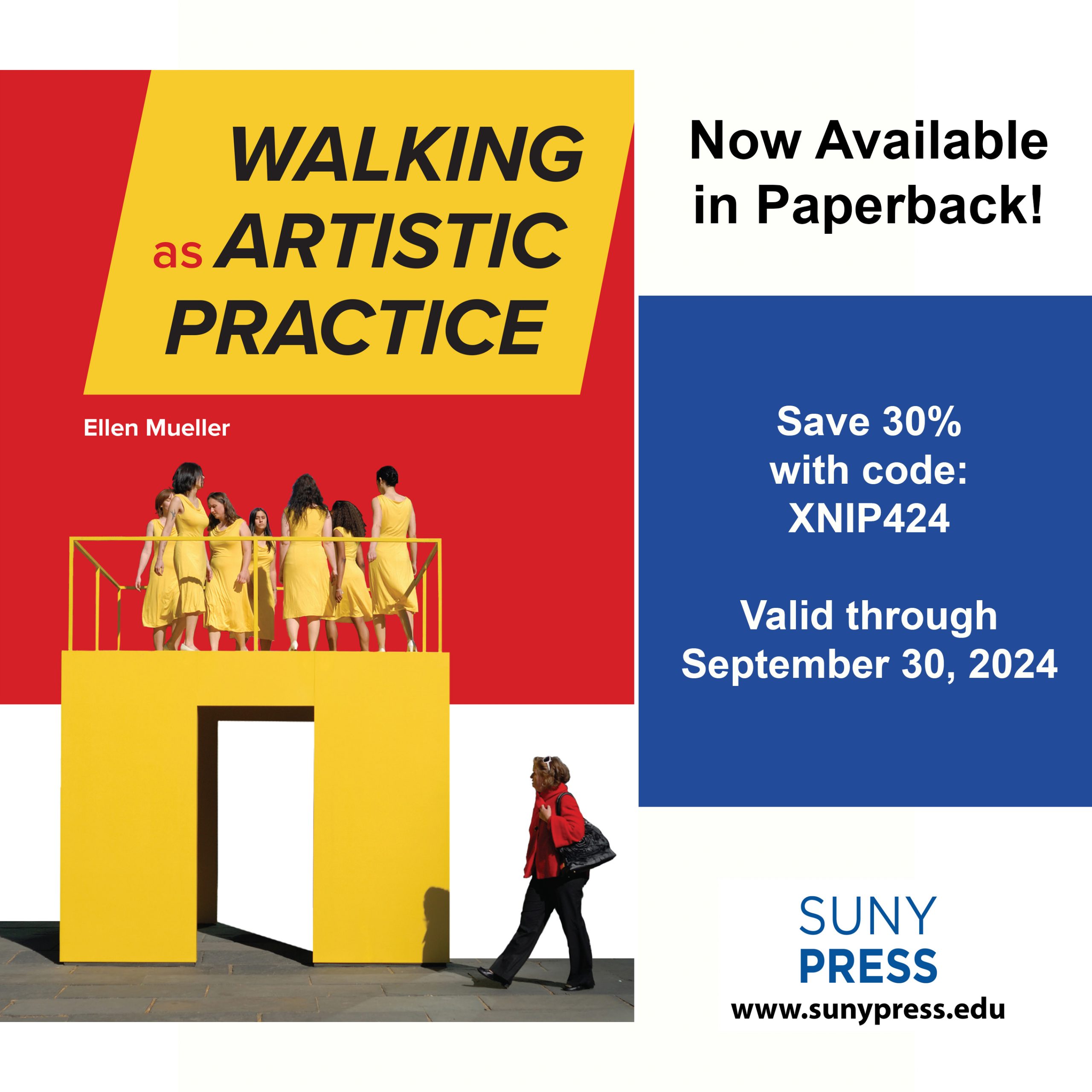
Good news! If you’ve been waiting to buy a copy of Walking as Artistic Practice, my publisher just shared this discount code!
XNIP424
Please share widely, and when your copy arrives, please post a pic to Instagram and tag me – I’ll re-share!
by Ellen Mueller on March 11, 2024, no comments

Good news! If you’ve been waiting to buy a copy of Walking as Artistic Practice, my publisher just shared this discount code!
XNIP424
Please share widely, and when your copy arrives, please post a pic to Instagram and tag me – I’ll re-share!
by Ellen Mueller on February 18, 2024, no comments
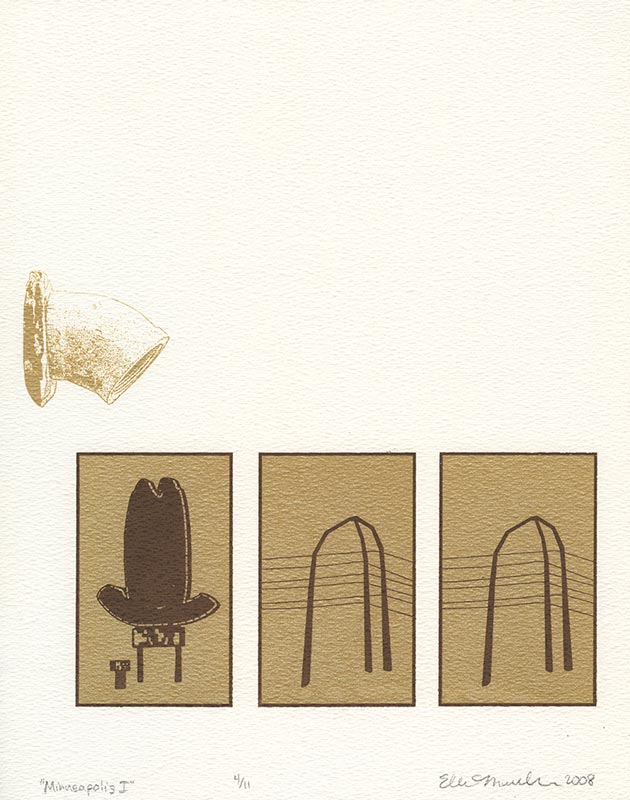
Doing some deep cleaning, I posted some 2008 screen prints, Minneapolis Series, to my shop – check it out!
by Ellen Mueller on February 12, 2024, no comments
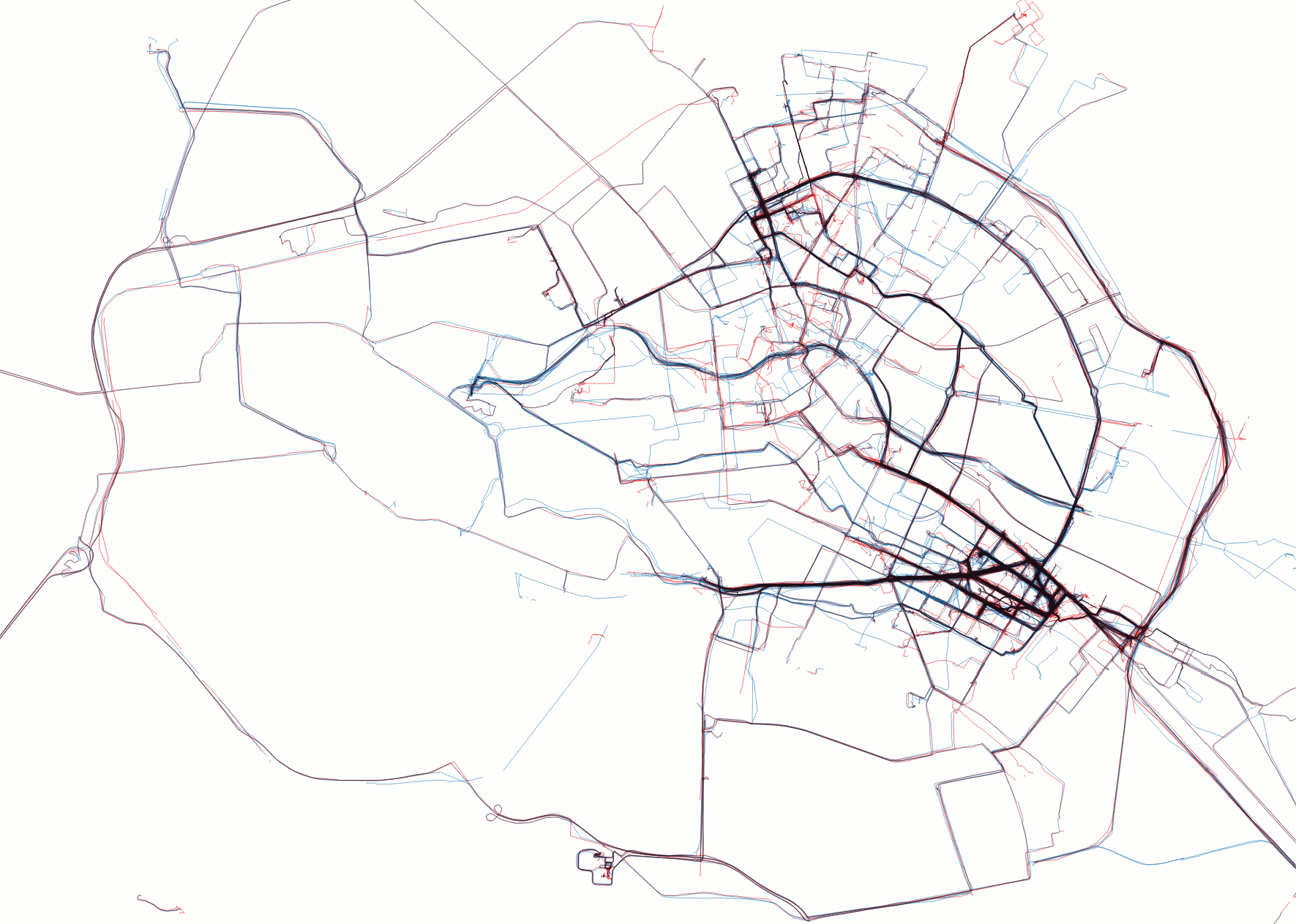
Sophia New and Daniel Belasco Rogers “All GPS Traces in Berlin in 2011-2012”
As part of the release of my book, Walking as Artistic Practice (pre-orders now open for softcover shipping in April!), I’m going to be publishing some brief interviews with the various artists, authors, researchers, creatives, collectives, and platforms whose art practice, written material, or other works I cite and mention.
My 26th interview in this series is with Sophia New and Daniel Belasco Rogers who have worked together as the performance duo plan b since moving to Berlin in 2001. Originally from London, their work is concerned with site, intimacy, public space, technology and durational performance. They have a long-term practice of recording everywhere they go, everyday, with a GPS. From this collection they make prints, drawings, performances, video works, sculptures and carpets. As well as exhibiting and performing internationally, they have a pedagogical practice that has seen them give workshops in Banff in Canada, UC Berkley, São Paulo, Tokyo and Helsinki among other locations. Since 2010, they have regularly taught on a variety of courses including Hafen City University, Hamburg, Hochschule für Grafik und Buchkunst, Leipzig, Folkwang Universität der Künste and the University of Arts, London. Between 2020–2023 they were guest professors for Studium Generale at the University of Arts Berlin.
EM: First, thank you for chatting with me about your collaborative work, All GPS Traces in Berlin in 2011-2012 (2012). I cite this project in chapter two (Analyzing Walking Works) in the subsection on “Forms>Two-Dimensional.” How would you describe the project for people who might not be familiar with it?
SN & DBR: This is less of a project for us and more of an ongoing life practice: we have been recording everywhere we go for over 20 years now. It started when we relocated from London to Berlin to see how we were moving in a new city. Dan started this by doing it manually but by chance came across a GPS on a residency and realised that was a way of ‘drawing’ the traces. We call this practice ‘The Drawing of our Lives’. Very concretely, we take a GPS (the old, clunky type, not our smart phones – they weren’t around when we started) with us every time we leave our flat or any building we are in, turn it on and record every journey we take. Over time, what is inevitably revealed, much like a rubbing on something textured, is the structure of Berlin, the city we have lived in for two decades. Because it reveals urban structure, it is sometimes referred to as mapping but if it is a mapping, then it is a mapping ‘from below’ rather than from above (sousveillance not surveillance), at the level of the street, rather than the all-seeing bird’s / satellite’s / drone’s eye view. As artists moving between visual art and performance, our practice is often to ‘narrate’ these drawings, revealing the human events in the seemingly abstract if recognisable traces. Alongside the thousands of everyday, forgotten trips to shops in our drawings, are monumental life events like driving back from the birth house with our newly born daughter in 2005.
EM: What are your thoughts on walking as artistic practice?
SN & DBR: As artist researchers and pedagogues we reflect on walking quite a lot but our GPS drawings record every movement above ground, regardless of whether it is made on foot, on a bike, in a car, a bus, a train or a boat. It allows for contemplative, reflective processes and experimentation. We often refer to the derive, Situationalism and pyschogeography but also algorithmic walks instigated by Williem Van de Bek. Dan has taken part in the sideways festival in 2012 and go to meet the anthropologist Tim Ingold whose work we have always admired. The Walking Artist Network is also a great resource that we refer to. As keen cyclists we are also reminded when walking what different speeds allow you to see, often more detail and unnoticed elements. As an artistic practice it is about framing an experience of looking when moving and finding new modes of perception.
EM: Can you tell us about any upcoming or recent projects you are excited about?
SN & DBR: Being so embedded in our daily lives and continuous, our practice is, to a certain extent, seasonal. The traces blossom and flower in spring and rather retread indoors in winter, especially in Berlin. One indoor activity we can always partake in is our relatively recent method of making the digitally recorded traces material through wool carpets that represent time spent inside and outside. Each carpet represents the movements of one of us for one year and is comprised of 365 rows, one row per day and 72 knots across where one woollen knot represents 20 minutes. If we were outside, the knot is black, otherwise it is natural wool colour. We refer to these works as Knotting Time and you can see them here https://planbperformance.net/w
by Ellen Mueller on February 5, 2024, no comments
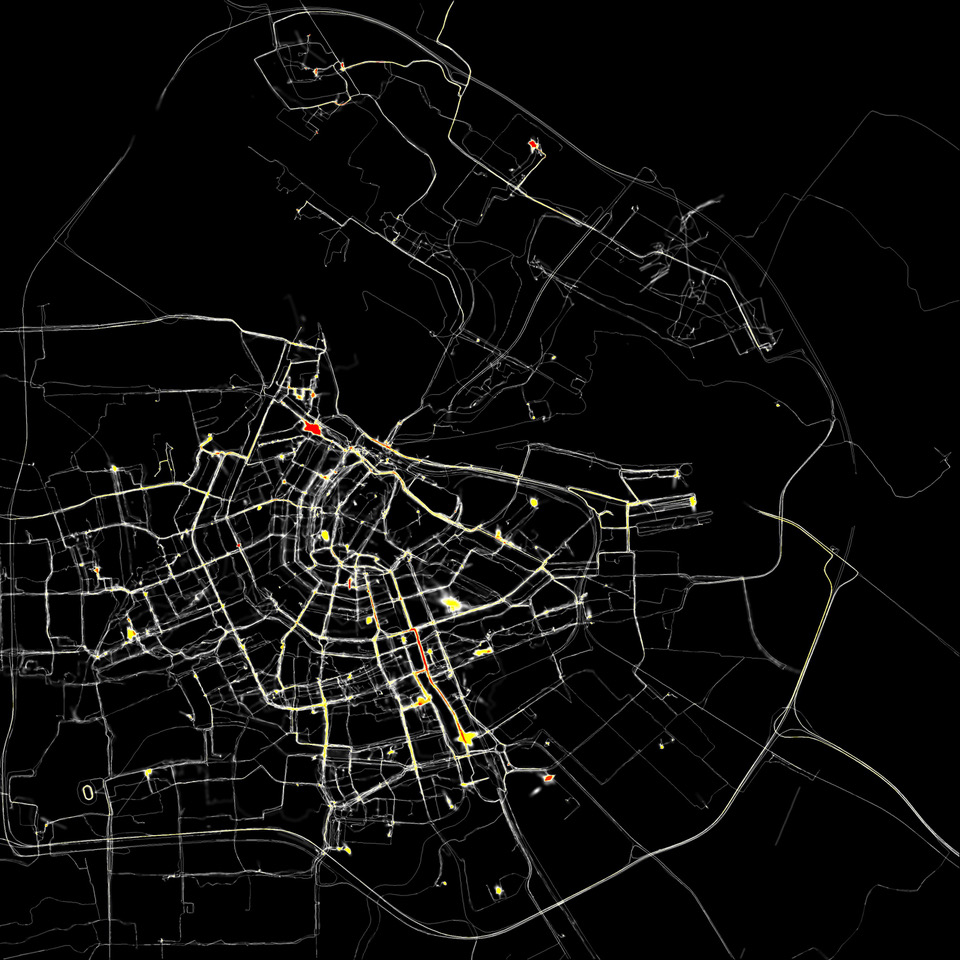
“AmstedamRealtime” digital print (2002)
As part of the release of my book, Walking as Artistic Practice (pre-orders now open for softcover shipping in April!), I’m going to be publishing some brief interviews with the various artists, authors, researchers, creatives, collectives, and platforms whose art practice, written material, or other works I cite and mention.
My 25th interview in this series is with Esther Polak who explores choreographies of daily life: walking, cycling, driving, flying, and wandering. In their view, the drive to move creates a world or space rather than taking place in an already existing one. Rooted in the Dutch realistic landscape depiction history, they express personal experiences of moving and space. Collaborations with participants often inform their projects, be it humans, animals, or even the rays of the sun. PolakVanBekkum is/are supported by the Mondriaan Fund and Dutch Film Fund. Their work is part of private and public collections and has been show at exhibitions and (film)festivals.
EM: First, thank you for chatting with me about your collaborative work, AmsterdamREALTIME (2002, with Jeroen Kee and Waag Society). This piece is mentioned in Walking as Artistic Practice chapter nine, “Connections to Drawing,” in the subsection on “Technology and Mapping,” because this work involves GPS to create visualizations. How would you describe this work for people who might not be familiar with it?
EP: I think the first thing that is really important for this work is that it was made in 2002, and that was really a year after the use of GPS technology was even given free for civilian use. Because first it was only developed as a military tool, and that change was the backdrop of this project. So the public, most people, had no experience with GPS at all, let alone with being able to record their own trajectories and see them. Of course, there was a long tradition of maps, but they were always made at a totally different moment than the moment that the walk or whatever move actually took place.
And the interesting thing about GPS was that you could move around in the world, for example, walking and drawing your map or at least your trajectory, at the same time. And that was what is very important for this work. I sometimes compare it with the first photography – the first photographs made a total new way of relating space to visual memory possible. And I think the emergence of GPS technology also makes a total new relation to space and the concept of memory possible. And that was what fascinated – fascinates me still – about this project.
To describe it, the idea was to realize the possibility for Amsterdam citizens to record their own movements in the city and to in real time visualize that in an exhibition space. And that was really innovative at the time. So we invited the project to last for six weeks, and we then were able to develop, I think 10 drawing devices. And that was really innovative because it combined the GPS information with a method of connecting with exhibition space in real time. So now we are very used to mobile phones that can both – that can directly show your location through wifi or through your cell connection to another person and even your trajectory. But back then there was something totally new.
So the audience entered that exhibition space and they saw a huge black screen with little white lines emerging. And when they were moving, you were, you knew that that was a person that was going about there at that very moment. That’s also why it was called AmsterdamREALTIME. And Amsterdam was a very nice city too, it was the city I was born in, so it was, it’s my city. It was a very nice city to develop this project because it has such a very distinct circular map. So it has a very interesting, almost like a fingerprint layout. So that was really, for me, it was really groundbreaking.
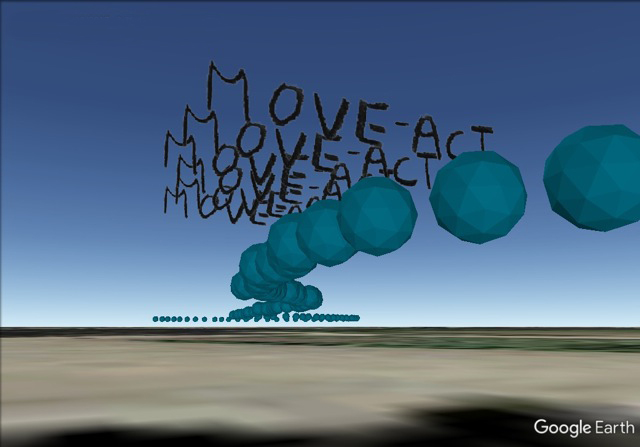
The City as Performative Object 2017 (Move-Act) filmstill
EM: What are your thoughts on walking as artistic practice beyond AmsterdamREALTIME?
EP: AmsterdamREALTIME was really a sort of key work for me, and from it, I developed a whole method of thinking about mobility in general. So for me, the interesting thing about human walking is that humans not only walk – walking is only one category of mobility that we employ. So we also, especially in Amsterdam, many of the participants in AmsterdamREALTIME went by bike because that is the most, especially 20 years ago, but still the most normal way of going about in the city for the people who actually live there.
I started to be really interested because we had participants that were pedestrians that that went by bike, and that then went by automobile, which is very inconvenient in Amsterdam. I started to be really interested in these different categories of mobility possibilities. And I called it Move Act.
I was also interested in Judith Butler, who developed a whole theory on the categorization between genders, male and female. And I appropriated that to mobility. And I developed a whole line of thinking about mobility patterns and landscape depending on which me, which move, act category, move category you find yourself in. And that’s interesting.
For example, now we’re in my little studio in the east of the Netherlands, and that is at the border of one of our rivers, the isle. And because of lots of rain, the water is really high. So I’m going to show you what I’m see from my window. So instead of living alongside a river, it looks more like I live alongside a lake, but as you can see, trees there are halfway in the water. So in other seasons, I can go there and just walk in the flood lands, but now they are all flooded, as flood lands, the name says. But now you can only enter them, for example, with a little boat or canoe. And now I sometimes see people passing in their canoes. I realize that depending on your means of transportation, you are in a totally different landscape. So now the landscape actually totally changed because of the water. But, if you go through the same landscape one day, you go walking the next day, you go by bike, and another time you go by car, it is a different landscape than it is even as if the landscape really totally changes its identity.
Um, so instead of thinking of landscape as a given that you as a mobile entity decide to move through, I prefer to think of it as something that you produce by moving. So, I think when you choose walking as an artistic practice, then you decide for a specific means of transportation, and that will also determine the kind of landscape that you produce on the goal. I think, I hope, I can imagine that other artists who use that can feel, can recognize that, feel, that approach, but I think that the different means of transportation really make me aware of how productive it is to be mobile.
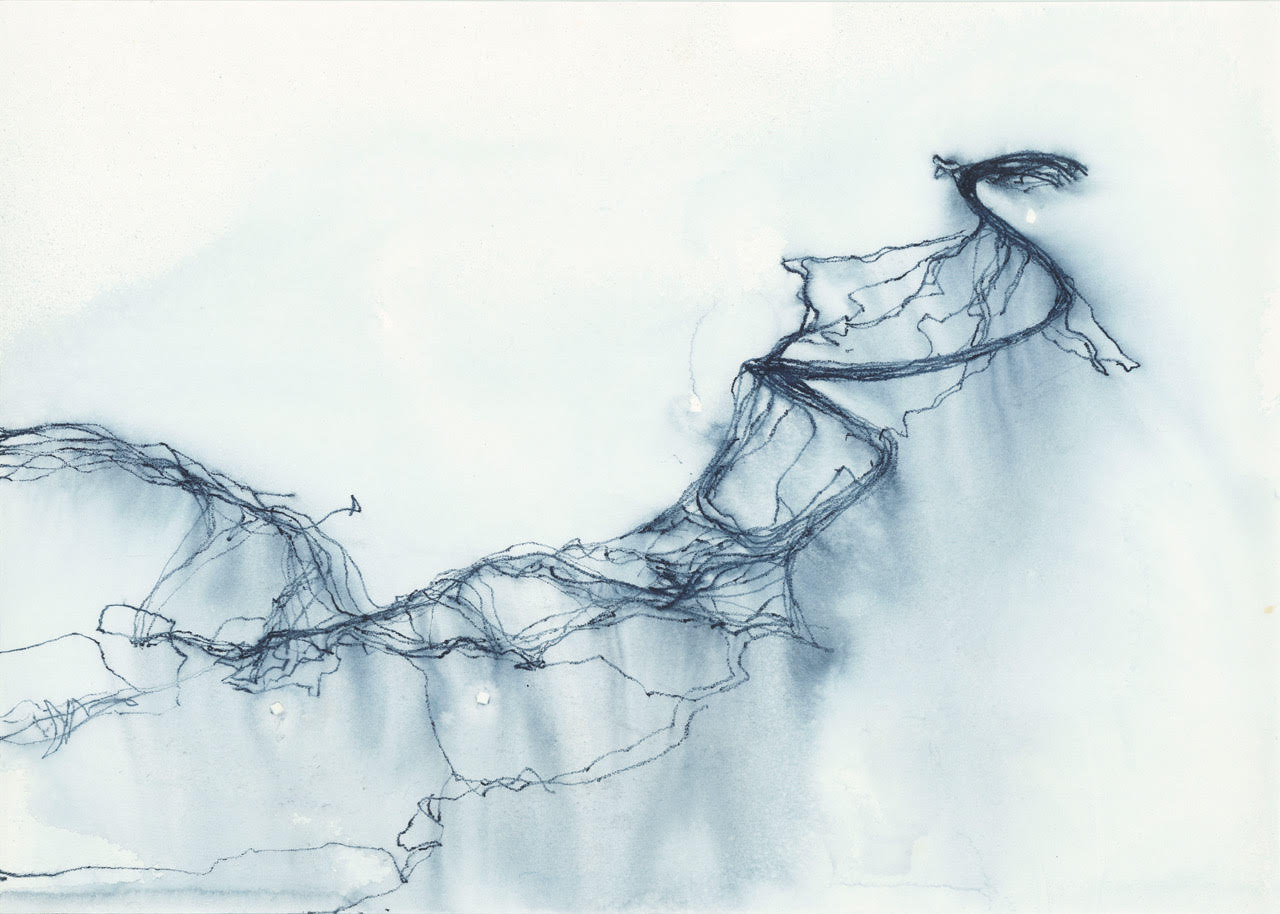
“Grazing Choreographies” 2019 drawing on paper
EM: Online biographies mention your interest in telling human stories. Can you discuss how another of your projects, NomadicMILK, does this with a focus on nomadic herdsmen in Nigeria?
EP: Your third question is about my interest in telling human stories, and the project I did in Nigeria with nomadic herdsmen. And, I feel more inspired to tell something about what was the start of that project. That was my fascination for grazing. Grazing is a very, for me, super fascinating act, but that is not really a human act, but more an act by animals because we humans, we don’t graze, we herd animals that graze. So maybe the animals graze for us and that makes us also a grazing species. I don’t know. But the grazing is super interesting because in the Netherlands you have an enormous culture of cow breeding, especially for milk protection. And I was very interested how that produces a specific kind of landscape, both from the human and from the animal perspective, I think.
The meadow as such can be seen like as an empty piece of paper where nothing has happened yet. But as soon as the meadow is being grazed, it is produced because if you leave a meadow without grazing in a couple of years time, it will become, it’ll become a forest because little plants will grow there, the more plants will grow there and nothing grazes it. And then in the end stage of the ecosystem will be a forest. So the meadow is always a landscape that is produced by grazing, and I was really interested in the mobility patterns that the grazing would bring about.
And in total, me and Eva, we are an artist couple, we did in total three different projects on grazing. The first project was, a project where we followed one dairy line from Latvia to the Netherlands. And that was more about the human stories, about how people were interacting with this chain of milk and how all participants in the milk chain describe their lives after a GPS recording we made with them.
And then I started to be really interested in that on a more global scale, and also on how milk production is globalized. And in Nigeria, for example, the milk production is both, depending on the nomadic milk herdsmen, who herd their cows in Nigeria, but also very much on international multinationals, and especially one Dutch one. So we followed not only the nomadic herdsmen, but also the people involved in the multinational milk production of powder milk in Nigeria because that turned out to be two total different projects.
And the third project on grazing that we did was super much more basic and simple, but also came with human stories. We decided to try to leave all technology behind and use our experience with GPS to develop a new method of drawing. So what we did was we were sitting next to a meadow and we started to draw the grazing patterns of the cows that are in the meadow. So we really took the time to observe them, to be a kind of a human GPS, be very patient and attentive to the cows, how they move. And we made drawings out of that. And we also wrote down our experiences during those observations. And that resulted in a book that is called Grazing Choreographies.
And in the coming spring, that’s why I really like to tell you about it. The coming spring, we are invited to an artist residency also here in the east of Netherlands, not very far from here, 20 kilometers further up east to develop these drawing methods further. And we are going to make the drawings now in a bigger scale. Also I want to be more connected to the farmers that we work with, so that also their perspective will be part of the project, which was not the case in the book that we already published.
So for me, walking is a very, is always contextualized, is one of the many possibilities of being in move-act. Also it is not limited to humans. I’m also super interested in, for example, grazing animals for now, but I can also imagine that that could be different animals or even machines. And especially my focus is on how those mobility move-acts, how they produce landscape instead of taking place in an already existing landscape.
by Ellen Mueller on January 29, 2024, no comments
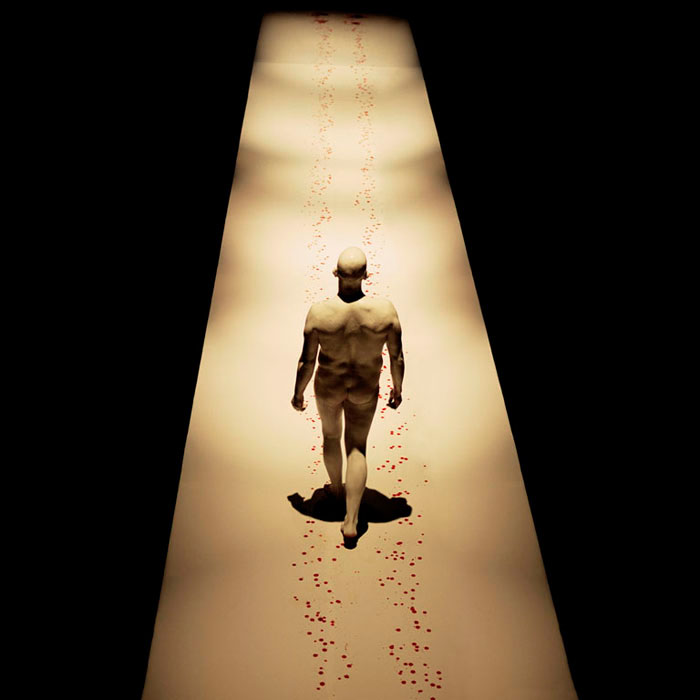
Franko B, “I Miss You” (1999-2005), performance still. Photo Credit: Manuel Vason
As part of the release of my book, Walking as Artistic Practice (pre-orders now open for softcover shipping in April!), I’m going to be publishing some brief interviews with the various artists, authors, researchers, creatives, collectives, and platforms whose art practice, written material, or other works I cite and mention.
My 24th interview in this series is with Franko B (born in Milan in 1960), who is an Italian visual artist based in London, where he has lived since 1979. He studied fine art at Camberwell College of Arts (1986–87), Chelsea College of Art (1987–90) and the Byam Shaw School of Art (1990–91). Includes performance video, photography, painting, installation, sculpture and Djing.
EM: First, thank you for chatting with me about your work I Miss You (1999-2005). I cite this work in chapter nine (Connections to Drawing) in the subsection on “Performance Links.” How would you describe the work for people who might not be familiar with it?
FB: visual art
EM: What are your thoughts on walking as artistic practice?
FB: we are always walking i like walking . as an. artist practice ?. i love art , if it move me it can be what it need s or want to be .i do what is necessary to the image i’m trying to making
EM: Can you tell us about any recent or upcoming projects you are excited about?
FB: life